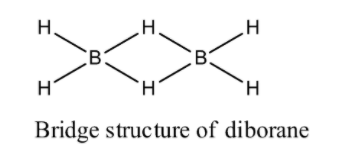
Answer
445.8k+ views
Hint: As we know diborane has twelve valence electrons and it is an electron deficient compound. Bridging boron- hydrogen bond has 3c-2e bonds and terminal boron hydrogen bonds in diborane have 2c-2e bonds. Layered structure is present in boric acid.
Complete step by step answer:
(1) Diborane: We know that molecular formula of diborane is ${{\text{B}}_{\text{2}}}{{\text{H}}_{\text{6}}}$ . Diborane has six hydrogen atoms and two boron atoms. It is an ethane like structure. From electron diffraction studies we see that diborane has a bridge structure in which two irregular ${\text{B}}{{\text{H}}_{\text{4}}}$ tetrahedral have one edge common. Two boron atoms and four terminal hydrogen atoms are lie in a plane of paper where remaining two hydrogen atoms are located centrally above and below the plane that have two boron atoms and four hydrogen atoms less or more bridging two boron atoms and therefore prevent the rotation between two boron atoms. Now we draw the structure of diborane:

(2) Boric acid: We know that molecular formula of boric acid is ${{\text{H}}_{\text{3}}}{\text{B}}{{\text{O}}_{\text{3}}}$ . Boric acid is an acid containing one atom of boron, three atoms of hydrogen and three atoms of oxygen. As we know it is a monobasic lewis acid. Now we draw the structure of boric acid:

Note:
We can see from nuclear magnetic resonance study and Raman spectra that four terminal hydrogen atoms are of one type while the remaining two bridging hydrogen atoms are different types in diborane.
Complete step by step answer:
(1) Diborane: We know that molecular formula of diborane is ${{\text{B}}_{\text{2}}}{{\text{H}}_{\text{6}}}$ . Diborane has six hydrogen atoms and two boron atoms. It is an ethane like structure. From electron diffraction studies we see that diborane has a bridge structure in which two irregular ${\text{B}}{{\text{H}}_{\text{4}}}$ tetrahedral have one edge common. Two boron atoms and four terminal hydrogen atoms are lie in a plane of paper where remaining two hydrogen atoms are located centrally above and below the plane that have two boron atoms and four hydrogen atoms less or more bridging two boron atoms and therefore prevent the rotation between two boron atoms. Now we draw the structure of diborane:

(2) Boric acid: We know that molecular formula of boric acid is ${{\text{H}}_{\text{3}}}{\text{B}}{{\text{O}}_{\text{3}}}$ . Boric acid is an acid containing one atom of boron, three atoms of hydrogen and three atoms of oxygen. As we know it is a monobasic lewis acid. Now we draw the structure of boric acid:

Note:
We can see from nuclear magnetic resonance study and Raman spectra that four terminal hydrogen atoms are of one type while the remaining two bridging hydrogen atoms are different types in diborane.
Recently Updated Pages
How many sigma and pi bonds are present in HCequiv class 11 chemistry CBSE

Mark and label the given geoinformation on the outline class 11 social science CBSE

When people say No pun intended what does that mea class 8 english CBSE

Name the states which share their boundary with Indias class 9 social science CBSE

Give an account of the Northern Plains of India class 9 social science CBSE

Change the following sentences into negative and interrogative class 10 english CBSE

Trending doubts
Which are the Top 10 Largest Countries of the World?

Fill the blanks with the suitable prepositions 1 The class 9 english CBSE

Difference Between Plant Cell and Animal Cell

Differentiate between homogeneous and heterogeneous class 12 chemistry CBSE

Give 10 examples for herbs , shrubs , climbers , creepers

Difference between Prokaryotic cell and Eukaryotic class 11 biology CBSE

Is the correct possessive form of Boss Bosss or Boss class 7 english CBSE

The Equation xxx + 2 is Satisfied when x is Equal to Class 10 Maths

How do you graph the function fx 4x class 9 maths CBSE



